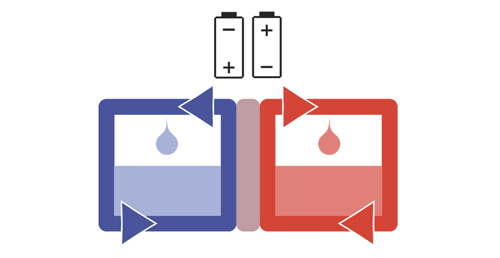High-power vanadium redox flow batteries

To overcome the challenges of direct usage of renewable electricity in power grids, the distributed electricity production requires the similarly distributed electricity storage system. Here, large-scale battery energy storage systems (BESS) can be used for buffering loads at strategic network nodes to alleviate congestion in storage-as-transmission. With a plethora of available BESS technologies, vanadium redox flow batteries (VRFB) are a promising energy storage candidate. However, the main drawback for VRFB is the low power per area of the cell. In this project we will address the mechanism of VRFB operation at both molecular and device levels. We intend to explore the catalysis of the reactions happening on positive and negative electrodes of VRFB to boost the current output of VRFB.
Challenges of renewable electricity
The low cost of renewables have catalyzed a mass-scale adoption of renewable energy sources that will further gain momentum in coming years. This shift towards intermittent sources, however, poses unprecedented challenges for power grids due to mismatches between supply and demand both in time and, crucially, location. For instance, solar power generation drops off in the evening sunset just before peak demand, creating the difference between energy demand and the amount of available solar energy throughout the day. Moreover, transmission limitations result in variations of real-time electricity prices of hundreds of dollars per MWh between locations that are separated by only a few kilometres. The extreme variability of congestion costs indicates that with more distributed energy production, a similarly scaled distributed energy storage system is needed to mitigate the expansion of transmission and distribution infrastructure.
Battery energy storage systems (BESS)
Here, large-scale BESS can be attractive by buffering loads at strategic network nodes to alleviate congestion in what has been called storage-as-transmission, or ‘‘Grid Booster’. To achieve deep decarbonization of the power grid and to relieve congestion without large-scale construction of expensive power lines, considerable energy storage will be necessary in densely populated areas as well. This makes safety and footprint of BESS installation an important part of the design. With a plethora of available BESS technologies, VRFBs are widely considered a promising energy storage candidate. The uniqueness of VRFB is the possibility to set independently the power of the battery by the size of the device and the energy for the battery by the size of the tank for liquid reagents. However, the main drawback of VRFB is the low power per area of the electrode/cell, which implies that the cell must be large to produce a certain amount of power and/or that multiple cells must be assembled in parallel to increase the power, which increases the costs. On another side, VRFB is aqueous, which implies lower costs on thermal management in comparison with other BESS. In parallel, vanadium electrolyte can be 100% recycled.
Challenges of VRFB addressed by our project
Existing VRFB still have a low energy density. Our collaborative project is focused on this problem. The rate capabilities of VRFB are limited by the slow kinetics of posolyte reaction because of its complex mechanism. The detailed mechanism of posolyte reactions of VRFB is not resolved yet as well as the individual and combined roles of electrolyte, membrane and electrodes. We are using physicochemical techniques positive electrode process on. Then, we will utilize this knowledge at the higher level of the device operation: the combination of electrode, electrolyte and the membrane. The cross-contamination of active components of positive and negative electrodes, the main reason of VRFB failure, will be also investigated on the device level. Finally, we intend to create the comprehensive model of the device to help the design of the high-power VRFB.
Involved in the project
Mikhail Vagin, Pawel Wojcik, Miguel Villicana Aguilera, Penghui Ding, Reverant Crispin, Viktor Gueskine
Partners
Linköping University, RedoxMe, Swedish Energy Agency